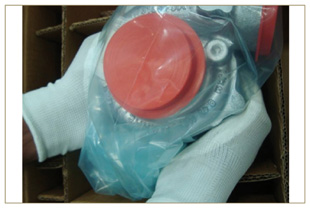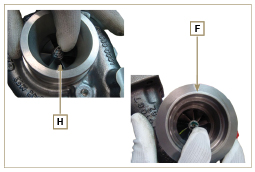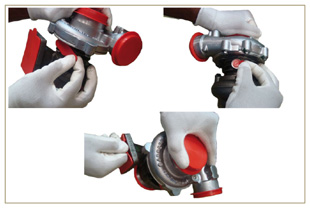|
2.18.1 What to do and what not to do
What to do:
- Before assembling the turbocharger, make sure that the protection caps are fitted on all openings of the turbo.
- Ensure pre-lubrication of the turbocharger.
- Periodically check that the joints are sealed against oil and air.
- Use lubricating oil according to the specifications described in Par. 2.4.
- Check the engine oil level.
- Before switching it off after it has been used, make the engine run idle, or without a load, for approximately 1 minute.
- Ensure that controls and maintenance intervals of the engine are observed as specified in Tab. 2.8 and 2.9.
- Make sure that the engine and equipment are used correctly so as not to compromise the life of the turbocharger.
|
What not to do:
- Do not store turbocharges in damp, wet places if they are not in their original packaging.
- Do not expose the turbocharger to dust and dirt if it is not in its original packaging.
- Do not lift of hold the turbocharger from the actuator rod if it is not in its original packaging.
- Do not apply additives to the lubricating oil and fuel, unless instructed to do so by Kohler.
- Do not increase engine speed, or apply loads, immediately after start-up.
- Do not intervene on the actuator settings A (Fig. 2.59).
- Do not let the vehicle / engine run at idle speed for more than 20-30 minutes at a time.
|
|
2.18.2 Practical operating rules
Users can help to maximise the duration of their turbocharger by following the rules described below.
- Start-up
Start the engine at idle speed, or without a load, for approximately one minute. Oil operating pressure is reached within a few seconds and enables the moving parts to warm up and be lubricated.
Immediately increasing the engine speed upon start-up means making the turbocharger run at high speed with suboptimal lubrication, which may compromise the life of the turbocharger.
- After maintenance or a new installation
Proceed with pre-lubrication by filling new oil into the oil supply duct B until filling it completely. Start the engine at idle speed, or without a load, for a few minutes in order to ensure that the oil and bearings system operate satisfactorily.
- Low temperature air or engine inactivity
If the engine has been inactive for some time, or the air temperature is very low, start the engine at idle speed or without a load for a few minutes.
- Engine shutdown
Before switching the engine off after intense activity, one must allow the turbocharger to cool down. One must therefore let the engine run at idle speed or without a load for at least 2 minutes, thus allowing the turbocharger to cool.
- Engine at idle speed
Avoid using the engine at idle speed or without a load for long periods (more than 20-30 minutes). When operating at idle speed or without a load, the turbocharger is at low pressure in the exhaust chamber C and air supply D; this may cause oil leaks from seals E
to the extremity of the shaft. Even if this does not cause damage, it can cause blue smoke from the exhaust when the engine speed and load are increased.
|

Fig 2.59

Fig 2.60 |
|
2.18.3 Before installing a new turbocharger
 Important Important
- Do not lift the turbocharger with one hand from the box.
- Do not lift turbocharger from Comp hsg side.
- Lift the turbocharger with both hands from box.
- Make sure to use clean gloves.
- Handle the turbocharger as indicated in Par. 2.17.4.
|

Fig 2.61 |
- Avoid lifting from the intake side G.
- Remove cap guard F and check that there is no excessive shaft axial and radial clearances.
|

Fig 2.62 |
- Check for any signs of friction of the turbine on the turbocharger body.
- Check for any traces of oil leaks on the turbocharger body.
- After having check everything, reapply cap F on intake opening H of the turbocharger and do not remove it until assembly has been completed.
|

Fig 2.63 |
- Check the correct assembly of the capscrews and the presence of paint on them.
|

Fig 2.64 |
|
2.18.4 Installation instructions
- Remove the cap guards with care only when assembling.
Handle carefully avoiding erratic movements.
|

Fig 2.65 |
|
2.18.5 Replacement instructions
Always understand the cause of the breakage of the turbocharger before replacing it.
Correct the cause of the breakage before replacing it with a new turbocharger.
If in doubt, contact KOHLER service department.
 Important Important
- Failure to comply with these instructions can cause damage to the turbocharger and void the warranty.
- Modifying the calibration of the turbocharger damages the turbocharger/engine.
- Always use the correct gaskets, and fit carefully to avoid blocking holes when mounting.
- Refer to the manual of the engine / vehicle, for: the correct type and quantity of oil, the correct tightening of components, instructions and installation.
- It is forbidden to use liquid gaskets or sealants, particularly for the oil inlet/outlet.
- Avoid dirt / debris while installing the turbocharger.
- Before mounting the turbocharger, check that the code of the component is correct for the type of engine, as mounting the wrong turbocharger can damage the turbo / engine and void the warranty.
|



 Important
Important




 Important
Important


 Loading
Loading